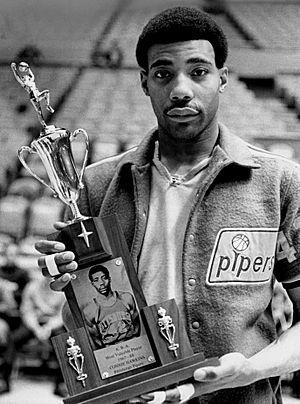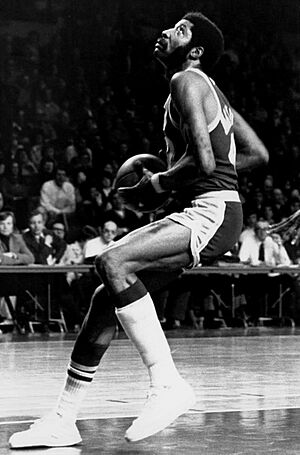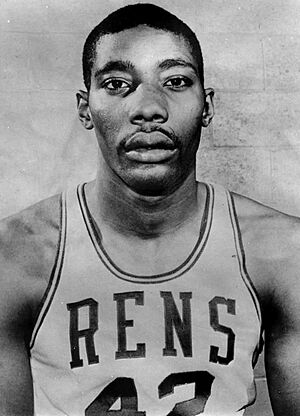Connie Hawkins facts for kids

Hawkins with the ABA's most valuable player award in 1968
|
|
| Personal information | |
|---|---|
| Born | July 17, 1942 Brooklyn, New York, U.S. |
| Died | October 6, 2017 (aged 75) Phoenix, Arizona, U.S. |
| High school | Boys (Brooklyn, New York) |
| Listed height | 6 ft 8 in (2.03 m) |
| Listed weight | 210 lb (95 kg) |
| Career information | |
| NBA Draft | 1964 / Undrafted |
| Pro career | 1961–1976 |
| Career history | |
| 1961–1963 | Pittsburgh Rens |
| 1963–1967 | Harlem Globetrotters |
| 1967–1969 | Pittsburgh/Minnesota Pipers |
| 1969–1973 | Phoenix Suns |
| 1973–1975 | Los Angeles Lakers |
| 1975–1976 | Atlanta Hawks |
| Career highlights and awards | |
|
|
| Career ABA and NBA statistics | |
| Points | 11,528 (18.7 ppg) |
| Rebounds | 5,450 (8.8 rpg) |
| Assists | 2,556 (4.1 apg) |
Cornelius Lance "Connie" Hawkins (July 17, 1942 – October 6, 2017) was an amazing American professional basketball player. Known as "the Hawk", he was a legend on the playgrounds of New York City. In 1992, he was honored by being inducted into the Naismith Memorial Basketball Hall of Fame.
Contents
Growing Up and Playing Basketball
Connie Hawkins was born in Brooklyn, New York. He went to Boys High School and played basketball there. Connie quickly became a regular at Rucker Park. This famous outdoor court was where he played against some of the best players in the world.
He didn't play much until his junior year of high school. But then, he became an All-City first team player. His team, Boys High, went undefeated and won the New York Public Schools Athletic League (PSAL) title in 1959. In his senior year, he scored an average of 25.5 points per game. He even scored 60 points in one game! Boys High won the PSAL title again in 1960. After high school, Hawkins planned to play at the University of Iowa.
An Unfair Challenge
During his first year at Iowa, Connie faced a big problem. His name came up in connection with a basketball scandal that started in New York City. Even though he was a freshman and couldn't play in varsity games yet, he was questioned by detectives.
Connie was never arrested or charged with anything. But because of these unfair accusations, he was forced to leave Iowa. No other college would offer him a scholarship. The commissioner of the NBA also said he wouldn't let Hawkins play in the league. This meant Connie was unfairly prevented from playing college or NBA basketball.
Starting His Pro Career
Playing for the Pittsburgh Rens
Since the NBA wouldn't let him play, Connie joined the Pittsburgh Rens. This team was part of the American Basketball League (ABL). The ABL was a new league trying to compete with the NBA. Connie played one season there and was named the league's Most Valuable Player (MVP).
Traveling with the Harlem Globetrotters
After the ABL stopped playing, Connie spent four years with the famous Harlem Globetrotters. He traveled the world, showing off his amazing basketball skills.
While with the Globetrotters, Connie decided to take action. He filed a large lawsuit against the NBA. He argued that the league had unfairly banned him. He said there was no real proof that he was involved in any wrongdoing.
Becoming an ABA Champion
Connie then joined the Pittsburgh Pipers in the new American Basketball Association (ABA). This was in the league's very first season, 1967–68. He led his team to an amazing 54–24 record. They went on to win the 1968 ABA championship! Connie was the top scorer in the ABA that year. He also won both the regular season and playoff MVP awards.
The Pipers team moved to Minnesota for the next season. Connie had some knee injuries, which limited his playing time. After that season, the team moved back to Pittsburgh.
Connie's lawyers worked hard to prove his innocence. They showed that the evidence against him was not strong. The NBA realized they would likely lose the lawsuit. To avoid a big court battle, the NBA decided to settle with Connie. They agreed to let him play in the league.
As part of the settlement, Connie received a large payment. His rights were then given to the new Phoenix Suns team. Playing in the NBA had always been Connie's dream, so he quickly signed with the Suns.
NBA Career Highlights
Shining with the Phoenix Suns

In 1969, even while recovering from knee surgery, Connie started strong with the Phoenix Suns. He played 81 games and averaged 24.6 points, 10.4 rebounds, and 4.8 assists per game. In his final game of his first NBA season, he had an incredible 44 points, 20 rebounds, 8 assists, 5 blocks, and 5 steals!
The Suns made it to the playoffs that year. They faced the Los Angeles Lakers in a tough seven-game series. The Lakers had future Hall of Famers like Wilt Chamberlain, Elgin Baylor, and Jerry West. Connie led the Suns, averaging 25 points, 14 rebounds, and 7 assists per game in that series.
He continued to play well for the Suns for several more seasons. He was often the team's top scorer.
Playing for the Lakers and Hawks
In 1973, Connie was traded from the Suns to the Los Angeles Lakers. He played for the Lakers for a couple of seasons. Injuries started to limit his playing time more and more.
Connie finished his professional basketball career after the 1975–76 season. He played his final games for the Atlanta Hawks.
Amazing Achievements
Connie Hawkins was named to the ABA's All-Time Team. This means he was recognized as one of the best players ever in the ABA.
Even though knee problems limited his time in the NBA to only seven seasons, he achieved a lot. He was an NBA All-Star four times, from 1970 to 1973. He was also named to the All-NBA First Team in the 1969–70 season. The Phoenix Suns retired his No. 42 jersey. This is a huge honor, meaning no other Suns player will ever wear that number.
Despite the unfair ban early in his career, Connie's incredible performances in the ABL, ABA, and NBA earned him a spot in the Naismith Memorial Basketball Hall of Fame in 1992.
Career Statistics
| Bold | Means it was his best ever |
Regular Season Stats
| † | Means Hawkins' team won an ABA championship that year |
| Year | Team | GP | GS | MPG | FG% | 3P% | FT% | RPG | APG | SPG | BPG | PPG |
|---|---|---|---|---|---|---|---|---|---|---|---|---|
| 1961-62 | Pittsburgh (ABL) | 78 | – | 42.9 | .509 | .167 | .790 | 13.3 | 2.3 | – | – | 27.5* |
| 1962-63 | Pittsburgh (ABL) | 16 | – | 41.8 | .491 | – | .770 | 12.8 | 2.6 | – | – | 27.9 |
| 1967–68† | Pittsburgh (ABA) | 70 | – | 44.9* | .519 | .222 | .764 | 13.5 | 4.6 | – | – | 26.8* |
| 1968–69 | Minnesota (ABA) | 47 | – | 39.4 | .511 | .136 | .767 | 11.4 | 3.9 | – | – | 30.2 |
| 1969–70 | Phoenix | 81 | – | 40.9 | .490 | – | .779 | 10.4 | 4.8 | – | – | 24.6 |
| 1970–71 | Phoenix | 71 | – | 37.5 | .434 | – | .816 | 9.1 | 4.5 | – | – | 20.9 |
| 1971–72 | Phoenix | 76 | – | 36.8 | .459 | – | .807 | 8.3 | 3.9 | – | – | 21.0 |
| 1972–73 | Phoenix | 75 | – | 36.9 | .479 | – | .797 | 8.5 | 4.1 | – | – | 16.1 |
| 1973–74 | Phoenix | 8 | – | 27.9 | .486 | – | .667 | 7.2 | 5.2 | 1.4 | 1.0 | 11.3 |
| 1973–74 | L.A. Lakers | 71 | – | 35.7 | .502 | – | .772 | 7.4 | 5.3 | 1.5 | 1.4 | 12.8 |
| 1974–75 | L.A. Lakers | 43 | – | 23.9 | .429 | – | .687 | 4.6 | 2.8 | 1.2 | 0.5 | 8.0 |
| 1975–76 | Atlanta | 74 | – | 25.8 | .447 | – | .712 | 6.0 | 2.9 | 1.1 | 0.6 | 8.2 |
| Career | 710 | – | 37.0 | .484 | .162 | .780 | 9.4 | 3.9 | 0.3 | 0.2 | 19.9 | |
Playoff Stats
| Year | Team | GP | GS | MPG | FG% | 3P% | FT% | RPG | APG | SPG | BPG | PPG |
|---|---|---|---|---|---|---|---|---|---|---|---|---|
| 1962 | Pittsburgh (ABL) | 1 | – | 53.0 | .609 | – | .929 | 17.0 | 4.0 | – | – | 41.0 |
| 1968† | Pittsburgh (ABA) | 14 | – | 44.0 | .594 | – | .729 | 12.3 | 4.6 | – | – | 29.9 |
| 1969 | Minnesota (ABA) | 7 | – | 45.7 | .378 | .500 | .645 | 12.3 | 3.9 | – | – | 24.9 |
| 1970 | Phoenix | 7 | – | 46.9 | .413 | – | .818 | 13.9 | 5.9 | – | – | 25.4 |
| 1974 | L.A. Lakers | 5 | – | 34.4 | .350 | – | .800 | 8.0 | 3.2 | 1.4 | 0.2 | 10.8 |
| Career | 34 | – | 43.8 | .473 | .500 | .743 | 12.1 | 4.5 | 0.2 | 0.0 | 25.5 | |
Personal Life
In 1975, Connie Hawkins appeared in a fun skit on NBC's Saturday Night Live. He played a one-on-one basketball game against singer Paul Simon. The skit showed Simon winning, even though Connie was much taller!
Connie's nephew, Jim McCoy Jr., was also a great basketball player. He scored a school record 2,374 points for the UMass Minutemen basketball team. Connie was also the grandfather of Shawn Hawkins, who played professional basketball internationally.
Connie Hawkins lived in Phoenix, Arizona, after he retired. He worked for the Suns team for many years, helping with community events. He passed away on October 6, 2017, at the age of 75.
Images for kids
See also
 In Spanish: Connie Hawkins para niños
In Spanish: Connie Hawkins para niños



